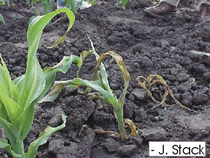Original content created by Dr. Jim Stack, former UNL Extension Plant Pathologist currently Kansas State University Extension Plant Pathologist. Content edited and approved by Dr. Tamra Jackson, UNL Extension Plant Pathologist.
Pathogen
Pantoea stewartii Mergaert et. al. (Erwinia stewartii). Bacterial structures: non-motile, gram negative, rod shaped bacterium. This bacterium occurs throughout the corn belt from the mid-Atlantic states to Nebraska. Until recently, this pathogen was rare in Nebraska; in 1999 it was reported in at least 22 counties across Nebraska. The bacterium overwinters within and is vectored by the corn flea beetle (Pulicari chaetocnema).

Disease Symptoms
Hybrids and inbreds vary in susceptibility to Stewart's Wilt. There are two phases of the disease each linked to the insect vector. Symptoms of the first phase are observed soon after emergence of the corn plant. External symptoms include bleached leaf streaks that may run the length of the leaf. Internal symptoms include discoloration of vascular tissues, oozing of bacteria from the cut surface of a stem cross section, and discoloration and decay of the crown. When severe, seedlings may wilt and die. The second phase of Stewart's Wilt is a leaf blight that occurs after tasseling. Plants are usually not killed by this phase but significant leaf area can be killed predisposing the plants to stalk rot.





Favorable Environmental Conditions
Weather conditions that favor the survival of the corn flea beetle favor the survival of the Stewart's Wilt bacterium. The incidence of Stewart's Wilt can be predicted based upon the survival of the corn flea beetle: if the sum of the mean temperature of December, January, and February is greater than 95 F then the population of the flea beetle will be high and the risk of Stewart's Wilt will be high.
Management
Stewart's Wilt is a quarantined pathogen requiring phytosanitary certification in many countries. Because of this it is a serious issue in seed production fields.
Genetic Resistance
Resistant hybrids are commercially available and are the best management option.
Chemical/Biological Control
Seed applied in furrow, and foliar insecticides are effective in reducing Stewart's Wilt. However, cost can preclude chemical management in many situations.








